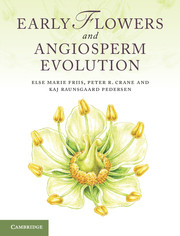Book contents
- Frontmatter
- Contents
- Preface
- 1 Introduction to angiosperms
- 2 The nature of the angiosperm fossil record
- 3 The environmental context of early angiosperm evolution
- 4 Stratigraphic framework and key areas for Cretaceous angiosperms
- 5 Angiosperms in context: extant and fossil seed plants
- 6 Origin and age of angiosperms
- 7 Phylogenetic framework and the assignment of fossils to extant groups
- 8 Fossils near the base of the angiosperm tree
- 9 Early fossil angiosperms of uncertain relationships
- 10 Early fossils of eumagnoliids
- 11 Fossils of monocots
- 12 Fossils of eudicots: early-diverging groups
- 13 Fossils of core eudicots: basal lineages
- 14 Fossils of core eudicots: rosids
- 15 Early fossils of eudicots: asterids
- 16 Patterns of structural diversification in angiosperm reproductive organs
- 17 History and evolution of pollination in angiosperms
- 18 History and evolution of dispersal in angiosperms
- 19 Vegetational context of early angiosperm diversification
- 20 The accumulation of angiosperm diversity
- References
- Index
2 - The nature of the angiosperm fossil record
Published online by Cambridge University Press: 07 September 2011
- Frontmatter
- Contents
- Preface
- 1 Introduction to angiosperms
- 2 The nature of the angiosperm fossil record
- 3 The environmental context of early angiosperm evolution
- 4 Stratigraphic framework and key areas for Cretaceous angiosperms
- 5 Angiosperms in context: extant and fossil seed plants
- 6 Origin and age of angiosperms
- 7 Phylogenetic framework and the assignment of fossils to extant groups
- 8 Fossils near the base of the angiosperm tree
- 9 Early fossil angiosperms of uncertain relationships
- 10 Early fossils of eumagnoliids
- 11 Fossils of monocots
- 12 Fossils of eudicots: early-diverging groups
- 13 Fossils of core eudicots: basal lineages
- 14 Fossils of core eudicots: rosids
- 15 Early fossils of eudicots: asterids
- 16 Patterns of structural diversification in angiosperm reproductive organs
- 17 History and evolution of pollination in angiosperms
- 18 History and evolution of dispersal in angiosperms
- 19 Vegetational context of early angiosperm diversification
- 20 The accumulation of angiosperm diversity
- References
- Index
Summary
The main sources of information on the timing and pattern of early angiosperm diversification have traditionally been studies of dispersed pollen and detached leaves (e.g. Doyle and Hickey, 1976; Hughes, 1976; Hickey and Doyle, 1977; Hughes et al., 1994). However, since about 1980 discoveries of well-preserved flowers and dispersed floral organs from sediments of Early and Late Cretaceous age have provided a large amount of new and previously unsuspected information, especially on the structure and systematic relationships of early flowering plants.
In this chapter we briefly consider the nature of the angiosperm fossil record, particularly in relation to studies of angiosperms from the Cretaceous. We review the difficulties introduced by the incompleteness of the fossil record, especially the biases that result from aspects of the biology of different kinds of plants and the particular circumstances under which fossil assemblages are preserved. We also discuss the most common types of angiosperm fossils, their preservation, and the implications of the nature of the plant fossil record for environmental and evolutionary interpretations based on palaeobotanical data. More extensive treatments of the nature and depositional aspects of the plant fossil record are given by Krassilov (1975b) and Behrensmeyer and Hook (1992), who also provide an entry into the substantial literature on this topic.
- Type
- Chapter
- Information
- Early Flowers and Angiosperm Evolution , pp. 23 - 38Publisher: Cambridge University PressPrint publication year: 2011

